
Valley of Flowers National Park is an Indian national park which was established in 1982. It is located in Chamoli in the state of Uttarakhand and is known for its meadows of endemic alpine flowers and the variety of flora. This richly diverse area is also home to rare and endangered animals, including the Asiatic black bear, snow leopard, musk deer, brown bear, red fox and blue sheep. Birds found in the park include Himalayan monal pheasant and other high-altitude birds.
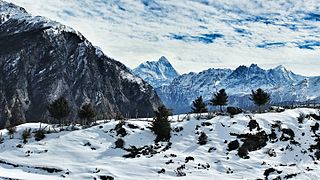
Uttarakhand (English:, or ; Hindi:[ˈʊtːərɑːkʰəɳɖ], lit. 'Northern Land'

Alpine plants are plants that grow in an alpine climate, which occurs at high elevation and above the tree line. There are many different plant species and taxa that grow as a plant community in these alpine tundra. These include perennial grasses, sedges, forbs, cushion plants, mosses, and lichens. Alpine plants are adapted to the harsh conditions of the alpine environment, which include low temperatures, dryness, ultraviolet radiation, wind, drought, poor nutritional soil, and a short growing season.

Saussurea is a genus of about 300 species of flowering plants in the tribe Cardueae within the family Asteraceae, native to cool temperate and arctic regions of East Asia, Europe, and North America, with the highest diversity in alpine habitats in the Himalayas and East Asia. Common names include saw-wort and snow lotus, the latter used for a number of high altitude species in East Asia.
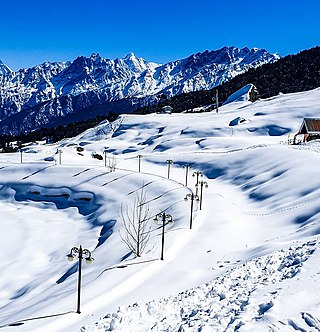
Auli is in Chamoli district in the Himalayan mountains of Uttarakhand, India. Auli, also known as Auli Bugyal, in Garhwali, which means "meadow", is located at an elevation of 2,800 metres (9,200 ft) above sea level. Between June and October, the valley has one of highest numbers of flower species found anywhere in the world, with 520 species of high-altitude plants, 498 of which are flowering plants with significant populations of endangered species.

Pithoragarh district is the easternmost district in the state of Uttarakhand. It is located in the Himalayas and has an area of 7,110 km2 (2,750 sq mi) and a population of 483,439. The city of Pithoragarh, located in Saur Valley, is its headquarters. The district is within the Kumaon division of Uttarakhand state. The Tibet plateau is situated to the north and Nepal is to the east. The Kali River which originates from the Kalagiri Mountain flows south, forming the eastern border with Nepal. The Hindu pilgrimage route for Mount Kailash-Lake Manasarovar passes through this district via Lipulekh Pass in the greater Himalayas. The district is administratively divided into six Tehsils: Munsyari; Dharchula; Didihat; Berinag; Gangolihat; and Pithoragarh. Naini Saini Airport is the nearest civil airport, but it does not have a regular scheduled commercial passenger service. The mineral deposits present in the district are magnesium ore, copper ore, limestone, and slate. There are 11 tehsils.

Rheum nobile, the Sikkim rhubarb or noble rhubarb or पदमचाल, is a giant herbaceous plant native to the Himalaya, from northeastern Afghanistan, east through northern Pakistan and India, Nepal, Bhutan, and Tibet to Myanmar, occurring in the alpine zone at 4000–4800 m altitude.
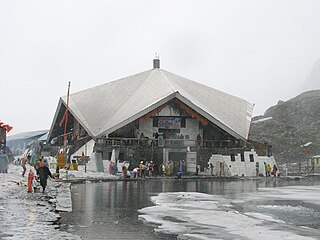
Gurdwara Hemkund Sahib is a Sikh place of worship (gurdwara) and pilgrimage site in Chamoli district, Uttarakhand, India. It is devoted to Guru Gobind Singh (1666–1708), the tenth Sikh Guru, and finds mention in Dasam Granth. With its setting of a glacial lake surrounded by seven mountain peaks, each adorned by a Nishan Sahib on its cliff, it is according to the Survey of India located in the Garhwal Himalaya at an elevation of 4,572 metres. It is approached from Govindghat on the Rishikesh-Badrinath highway. The main town near Gobindghat is Joshimath. The elevation of the lake at Hemkund is approximately 15,000 feet.

Bedni Bugyal is a Himalayan Alpine meadow and a hill station, situated at an elevation of 3,354 metres (11,004 ft) in the Chamoli district of Uttarakhand state of India. Bedni Bugyal falls on the way to Roopkund near Wan village. Trisul and Nanda Ghunti are clearly visible from here. This lush green meadow is adorned with blooms in a wide range of varieties. There is a small lake named Vaitarani situated amidst the meadow. The rich flora of the area includes 'Brahm Kamal' or Saussurea obvallata.

The Western Himalayan alpine shrub and meadows is a montane grasslands and shrublands ecoregion of Nepal, India, and Tibet, which lies between the tree line and snow line in the western portion of the Himalaya Range.
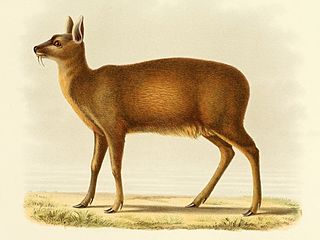
The Alpine musk deer is a musk deer species native to the eastern Himalayas in Nepal, Bhutan and India to the highlands of Tibet.

Gastrochilus distichus is a small species of orchid and pendant growing epiphyte. It is known by the common name distichous gastrochilus. It is found in Himalayas of India, Nepal, Bhutan, Assam, Sikkim, Tibet and Yunnan. It grows in the shade on moss covered rainforest at elevations of 1520–2700 m.

Uttarakhand has a total geographic area of 53,483 km2, of which 86% is mountainous and 65% is covered by forest. Most of the northern parts of the state are part of Greater Himalaya ranges, covered by the high Himalayan peaks and glaciers, while the lower foothills were densely forested till denuded by the British log merchants and later, after independence, by forest contractors. Recent efforts in reforestation, however, have been successful in restoring the situation to some extent. The unique Himalayan ecosystem plays host to many animals, plants and rare herbs. Two of India's great rivers, the Ganges and the Yamuna take birth in the glaciers of Uttarakhand, and are fed by myriad lakes, glacial melts and streams.
The ecology of the Himalayas varies with climate, rainfall, altitude, and soils. The climate ranges from tropical at the base of the mountains to permanent ice and snow at the highest elevations. The amount of yearly rainfall increases from west to east along the southern front of the range. This diversity of climate, altitude, rainfall and soil conditions supports a variety of distinct plant and animal species, such as the Nepal gray langur

Chandra Prakash Kala is an Indian ecologist and professor. His research interests include alpine ecology, conservation biology, indigenous knowledge systems, ethnobotany and medicinal aromatic plants. He is an assistant professor in the faculty area of Ecosystem and Environment Management at the Indian Institute of Forest Management.
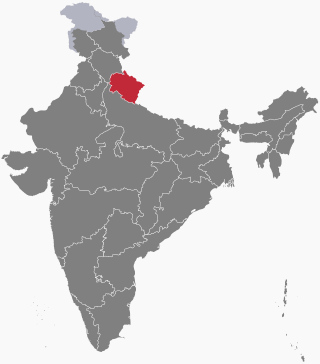
The following outline is provided as an overview of and topical guide to Uttarakhand:
Solms-laubachia himalayensis is a flowering plant in the family Brassicaceae. The specific epithet himalayensis is from the Latin, meaning "Himalayan".

Shrikhand Mahadev Kailash, also called Shikhar Kailash, is a Hindu pilgrimage site in Nirmand sub-division of Kullu, Himachal Pradesh, India, considered to be an abode of Lord Shiva and his wife Goddess Parvati. It is considered to be one of the toughest treks in India. It is the third most important peak among the group of five separate peaks in Himalayas in separate locations collectively known as the Panch Kailash or "Five Kailashas", other being Mount Kailash in first place, Adi Kailash in second, Kinnaur Kailash in fouth and Manimahesh Kailash in fifth place in terms of importance. The 75 feet Shivalingam at the top of the Shrikhand Mahadev mountain is at a height of 18,570 feet.
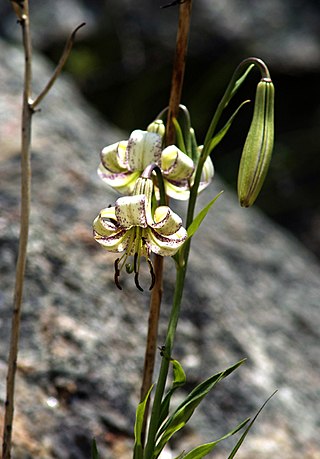
Lilium polyphyllum is a species of lily endemic to montane environments in central Asia.

















